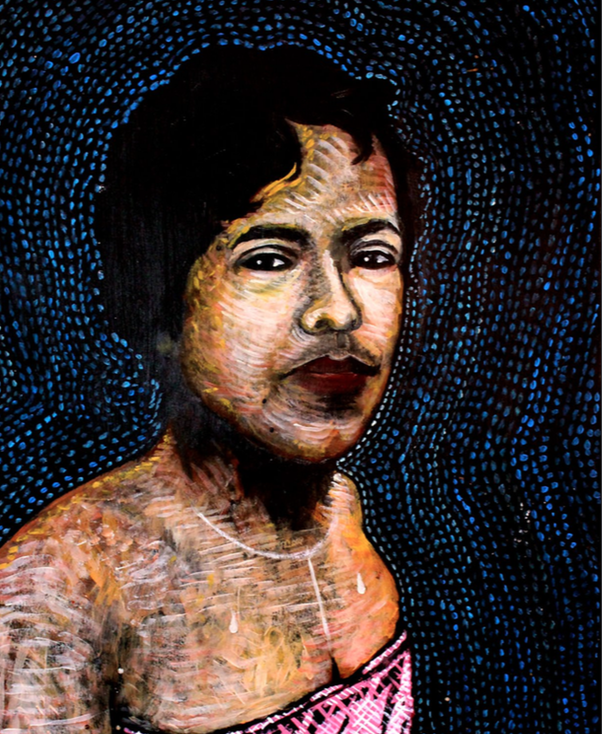
Binding(Self Portrait), acrylic on artboard
Kieran Castaño’s illustrations, paintings, and sequential works are humorous, seductively ambiguous, and poignantly vulnerable expressions, drawing form and content from contemporary politics, pop culture, art history, and underground comics. Castaño frequently culls his subject matter from politically-charged, personal experiences, creating representations of queer, androgynous, gender non-conforming, and trans subjects in identity-based, two-dimensional works. Working skillfully in both pen and ink and acrylics, Kieran Castaño approaches our contemporary moment with earnest humor and wit.

Everyone Holding the Head of Donald Trump II, acrylic on canvas
Comics occupy a special place in DIY communities and in grassroots activism. The sequential form’s accessibility, humor, and ability to convey narrative through image and spare text make comics an ideal platform for communication and self-representation. The history of comics in the United States is intertwined with that of mass-print media, and the ability to communicate with large numbers of people effectively, as well as the need to do it with style. Political satire makes many of the complexities and injustices of our world understandable at an emotional level.
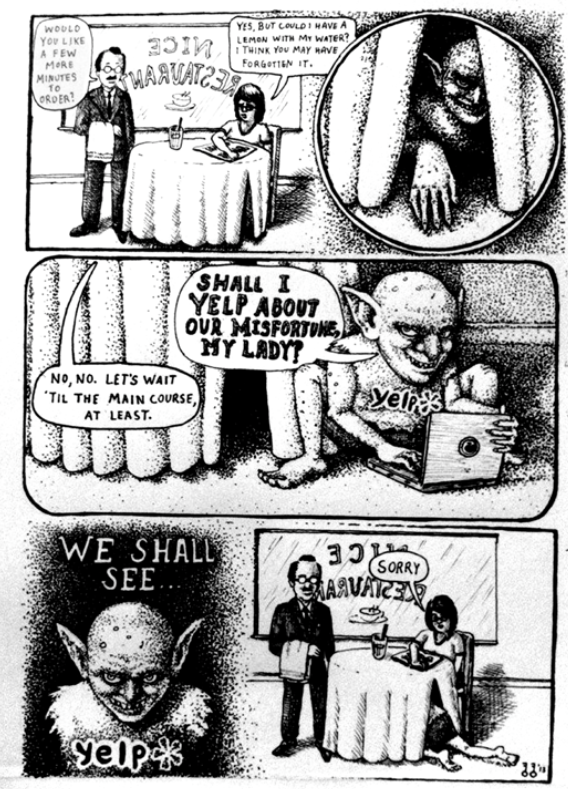
Yelper, pen and ink on paper
Stylistically influenced by the likes of R. Crumb and Daniel Clowes, Castaño’s comics are explorations of his daily existence, life as a trans man, pastiches of popular culture, and confessional self-portraiture, executed with technical virtuosity and precision in pen and ink. Batman, Walter White, and the Chik-Fil-A cow make cameo appearances throughout Castaño’s panels. Castaño’s stylization of an impish self character, consistently clad in a horizontally striped t-shirt and thick-rimmed glasses, is incredibly relatable in his millennial malaise, self-conscious anxiety, and affection for pizza and Flamin’ Hot Cheetos.
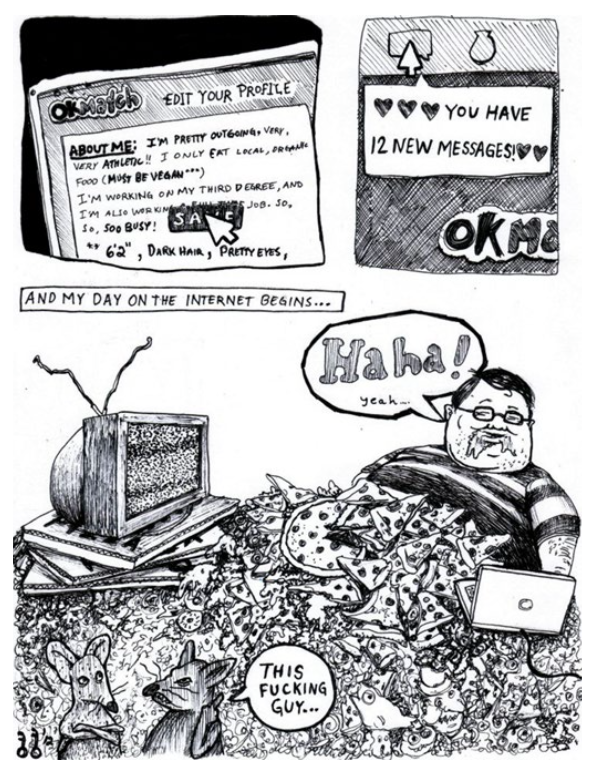
This Fucking Guy, pen and ink on paper
In one multi-panel comic, a bloated version of Castaño’s self character is managing an OkCupid profile with overflowing inbox from the depths of a throne of thousands of day-old pizza slices, with two rats in the foreground commenting on the scene, “this fucking guy…” A television with a snowy screen sits precariously atop three pizza boxes, silent witness to this quotidian moment. In Castaño’s comics, the mundanities of millennial life are celebrated in humor and honest vulnerability. In one single panel illustration, a grotesquely melting head adorned with a pustule is emblazoned with bubbly letters reading “same stupid shit every day.” In another illustration, Castaño’s drooling, intoxicated self character drunkenly stumbles home, followed by an owl (or so he thinks.) In another humorous sequence, off-brand vampire Nosferatu hides under the table at a restaurant during a date and writes Yelp reviews—“Should I Yelp about our misfortune, my lady?”

Same Stupid Shit Every Day, pen and ink on paper
In a departure from his humorous illustrations, Castaño’s series Trans Portraits are sumptuously rendered acrylic paintings of trans men and women, posed elegantly against gently abstracted backgrounds, invoking the history of portrait painting as idealization and depiction of beauty, and valorization of subject. “I wanted to focus on trans beauty in this series. You see a lot of paintings of cisgendered nude women and men, and I wanted to make trans bodies and gender nonconforming bodies to be beautiful and loved and not taboo.” These paintings are elegant representations of the nuances and ambiguities of physical features that are so frequently reduced to arbitrarily assigned, binary-gendered associations—the dark hairs on an upper lip, a gently sloping shoulder, an arched brow, a defined jawline, all of which we have mistakenly chained to arbitrary categories “boy” or “girl.”

Self Portrait and Other Weird Things, acrylic on canvas

Hoy Soy Bella, acrylic on artboard
Everyone With the Head of Trump is the first in a newly conceptualized series of overtly political paintings by Castaño; continued explorations of the medium which revitalize classical works from canonical Western art history in a way that is relevant to our contemporary world. In Everyone With the Head of Trump, Castaño references Caravaggio’s 1610 painting, David With the Head of Goliath, reimagined with David as a triumphant, ambiguously gendered person, and Goliath’s head a pucker-mouthed Trump, decapitated in a most satisfying defeat. This painting is angry and hopeful, an emotional state that is so difficult to maintain yet crucial during times of resistance. David was small and he defeated a giant brute with a slingshot. The invocation of such a familiar image, rooted in Judeo-Christian mythologies, is given contemporary relevance with politically-charged representations. “I want to press my trans views on our policies and government right now,” says Castaño. A deft application of archetypal imagery is a powerful communicative tool, the type of iconic representation that has potential to simply articulate our contemporary anxieties in pastiche. Castaño is currently working on the next painting in the series,which will be based on another canonical work by Caravaggio, The Incredulity of St. Thomas, and plans to continue his critique of contemporary politicians in this work.
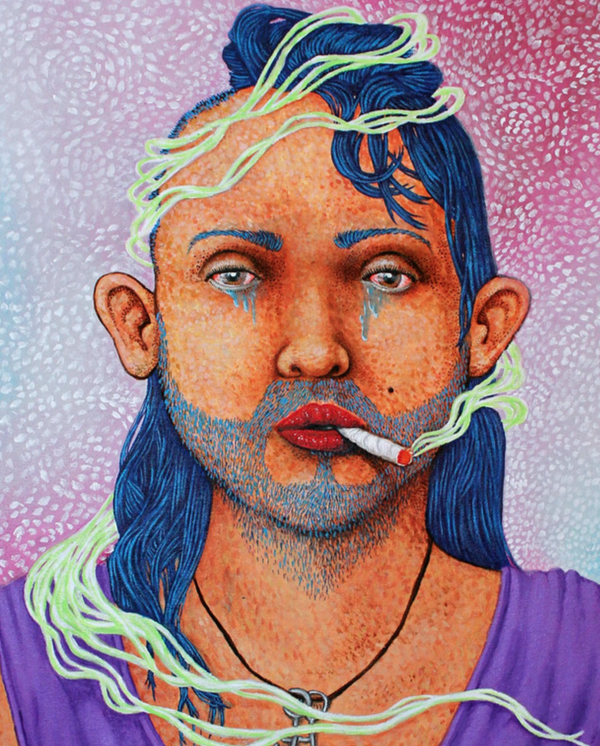
Self-Medication, acrylic on canvas
Political art is effective in its communicative nature. Kieran Castaño’s comics and paintings are honest and direct, the artist’s technical skills rising to the task of communicating our millennial cultural ethos. Through his representations of himself and others, Castaño resists a flattening of multifaceted and dimensional identities. As our current executive powers withdraw crucial laws protecting trans students’ rights, and as violence against trans people continues at astronomical rates without mainstream media outcry, it is critical to amplify voices within these communities, and to assert the value of nuanced representations of real individuals—to move beyond outmoded conceptions of the gender binary and its associated performances. We exist in a culture which violently reinforces its constructed gender binaries—ignoring or attempting to quash so many iterations and incarnations of how it is to be a human—through laws as well as mainstream consumer culture. Art occupies a space of accepted ambiguity, a space where social constructs are regularly challenged and subverted, where one can feel safe in experimentation with identity and self-expression. Art can serve, among other things, as a laboratory for a better culture, for a better understanding of humanness, and a place to assert a political emotion, where identity fiercely persists and resists and changes form. It is important to bring art outside of that laboratory and into the world, in all its newness and weirdness, fulfilling its communicative function and facilitating empathy and dialogue.

Cola, acrylic on canvas
Kieran’s work will be on view in the Art is a Drag artwalk in historic Sanford on April 15. He is the featured artist at Rabbitfoot Records, and his work will grace their walls until May 18.
You can see more at: KieranCastanoArt.wixsite.com/o-hi
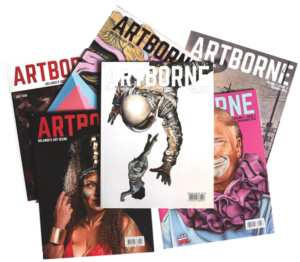
fuck yes Kieran